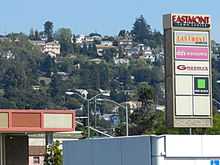Eastmont Town Center
Coordinates: 37°46′4.38″N 122°10′37.67″W / 37.7678833°N 122.1771306°W

Eastmont Town Center is a shopping mall and social services hub located on 33 acres (130,000 m2) bounded by Foothill Boulevard, Bancroft and 73rd Avenues, and Church Street, in the Eastmont neighborhood of East Oakland. The mall opened in 1970 on the site of a 1920's-era Chevrolet automobile factory. Architect William Pereira designed the building. It is physically almost next to, and by entry access a few blocks away from, the similarly sized Evergreen Cemetery.
History
Originally known as Eastmont Mall, the mall was a popular and heavily-used shopping destination during most of the 1970s and 1980s; but declined by the 1990s due to a huge drop in the average income level, and a concurrent increase in the crime rate in the mall and the surrounding neighborhoods.[citation needed]
Eastmont's primary anchor tenants were JCPenney, Mervyns, Woolworth's (including a lunch counter), Safeway, Pay 'n Save and Kinney Shoes, one of the nation's leading shoe retailers at the time. Hickory Farms had a location in Eastmont Mall, and there were also branches of Smiths and Roos/Atkins, both popular regional men's clothing stores. The mall also housed a Syufy movie theater, opened in 1971, with four screens. Food choices included Orange Julius, Karmelkorn and the H. Salt Esquire fast-food seafood chain.
The Safeway store was actually part of the first phase of the mall, a freestanding location fronting Bancroft Avenue, and opened in the spring of 1966. The other stores adjacent to it were opened by 1967. The JCPenney wing began construction in 1968.[1]
Eastmont's JCPenney store was notable in that the signage for it, outdoors and at the inside entrances, was never converted to the "JCPenney" logo, rendered in the Helvetica font, introduced chain-wide in 1970 and installed in all subsequently built Bay Area locations (including Richmond's Hilltop Mall); the Eastmont location always retained the older "Penneys" logo as originally introduced in 1963, right up until the store shut down (all signage and advertising inside the store itself always conformed to then-current branding). This may have been intentionally done by JCPenney to protect the trademark on the older logo.
Eastmont Mall became the only remaining indoor mall in Oakland after the closure of the MacArthur-Broadway Center in North Oakland in the mid-1990s.
JCPenney and Mervyns closed their Eastmont locations in the early 1990s. In the early 2000s, the mall was only 30 percent leased and had fallen into bankruptcy. Local real estate developers purchased the mall in 2000, and emphasized a focus on neighborhood and community services; many of the abandoned retail stores were converted into office space. The Mervyns location was converted into a substation for the Oakland Police Department and the JCPenney location was converted into a joint City of Oakland/Alameda County social services center. A handful of existing retail tenants stayed on, and a few new ones were attracted due to the success of the renovations, including Gazzali's Market (opened 2004), the only supermarket to serve the surrounding neighborhoods (this supermarket was a Safeway, as noted above, during the center's earliest years). In the spring of 2007, the mall was sold to a group of real estate investors based in Oregon.

A $6 million renovation of the property was completed in July 2008. The interior was brightened, new lighting, skylights and seating areas were installed, escalators and escalators were given an upgrade and the parking areas received new landscaping.
Currently, the mall houses the supermarket, a Social Security office, a branch of the Oakland Public Library, a primary care medical clinic operated by the Alameda County Medical Center, General Assistance and WIC offices, and other small businesses and social service organizations.
References
- ↑ "Oakland's Eastmont Mall". Mall Hall of Fame. Blogger.com. May 6, 2007. Retrieved September 24, 2013.
- "How shopping mall became the Eastmont Town Center"; Oakland Tribune, February 29, 2004
- "Rethinking an old box"; East Bay Business Times, November 10, 2000
External links
- "Unlikely tenants spur recovery of blighted mall", San Francisco Business Times, March 14, 2005
